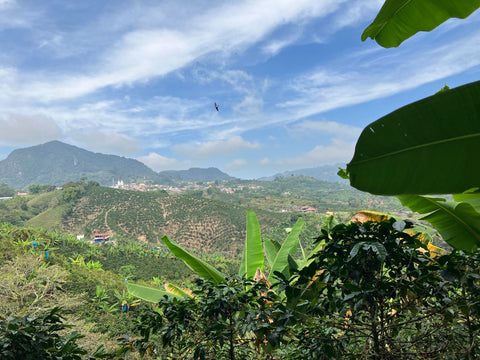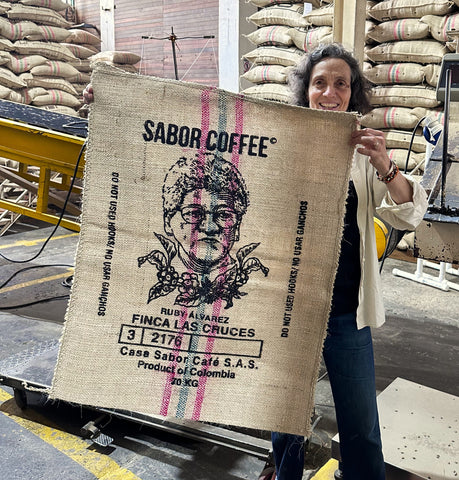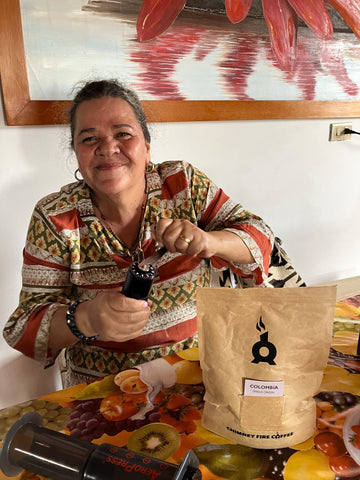International Women's Day 2024 - Ruby Alvarez de Cuartas
Ruby Alvarez de Cuartas is the matriarch of Finca Las Cruces, and she has been working in coffee for an incredible 70 years. Covering only ten hectares, this small family farm at 1750m altitude overlooks the rural coffee-producing town of Quinchía, 100km south of Medellín. It is part of the Colombian eje cafetero (coffee axis) in the UNESCO designated Paisaje Cultural Cafetero (Cultural Coffee Landscape).
This International Women’s Day, we are proud to share Ruby’s story, kindly translated from Spanish by Ruby’s son Helmer - brother of our friend and contact point for the farm, Esnayder. If you enjoy reading it, why not give their coffee a try!
We are now in our third year of partnering with Finca Las Cruces to bring you one of our most popular roasts, especially when it comes to cafetiere or filter brews. In January, our Head Roaster Elizabeth visited Ruby, Esnayder, and their family in Quinchía - many of the photos in this article were taken by her, and you can watch a video all about her adventures here.
Ruby, Tell Us About Yourself

My name is Ruby Alvarez, and I was born on 14th March 1941 in Anserma, Caldas, Colombia. Seven years later, with the death of Jorge Eliecer Gaitán, a very dark era of Colombian history called 'La Violencia' began.
I am the oldest of 15 siblings and my parents took me out of primary school when I was 12 years old, to help in the house with the upbringing of my siblings, who were at that time German, Edel and Mabel. We lived in the rural area of Las Cruces, on the farm of the same name, for that reason we walked to school every day back and forth.
I studied only until the third of year primary and learned to read and write. The school was only for girls and was located in the town of Quinchía, about 25 minutes walk from the farm where we lived.
I liked reading classes that were based on memorising the teaching booklets and learning the catechism (religion education). My brother German who was one year younger than me continued his studies until fifth grade, meanwhile I helped my mother in milking cows and then in the preparation of food for the rest of the day, arranging the house and general activities of a farm; how to cook for workers / labourers, up to 50 of them in harvest time.
I would get up at 4:30 in the morning and go to bed at 8 at night. I rode a horse which I liked a lot, and sometimes I went to another farm owned by my father to help prepare for the planting of coffee. It would take me an hour by horse to travel to Finca El Guaico. Then I started setting up the stove to prepare lunch for my father and the workers, because lunch was served from 11:30 to 12. Then I would stay at El Guaico all week to cook for all the workers.
I met my husband, Juvenal Cuartas, when I was 24 years old. Juvenal, who was a cabinetmaker, arrived at the Las Cruces farm to build some boxes for drying coffee. After a year and a half of courtship we decided to marry with the blessing of my parents, and we went to live at another farm owned by my father in the Betania area, Finca San Antonio - also a coffee farm - in the town of Anserma Caldas.
Due to political violence we decided to move from Anserma and then we returned to live in the town of Quinchía, already with two daughters, then we had three more children. We educated our children in Quinchía and they all graduated from high school.
I inherited part of the Las Cruces farm from my father in 1981 and we continued to grow coffee, plantain, and banana, and my husband at the same time had a joinery workshop, where almost all the joiners who still work as such in Quinchía trained. The Las Cruces farm where most of my siblings were born is still our property, and we still continue to grow coffee.

Today my daughter Liliana and my son Esnayder manage the farm, with my consent and that of their other brothers. My whole family, uncles, aunts and cousins, are part of the coffee culture, they are smallholders and coffee producers.
You have been a woman in coffee for 70 years... how has the Colombian coffee industry changed?
We women had to help with the drying and quality sorting of the coffee - separating the beans from the pasilla (coffee cherry skin) by hand by means of selection - the drying involved putting the coffee in the sun on planks, fabric tarpaulins, and drying boxes. In my time there were no drying silos and all the activity was manual. The coffee at the end of the day had to be picked up and brought into the house for its preservation and to prevent it from getting wet. Finally, we had to pack and store the coffee.
Today I see that coffee silos (mechanical dryers) and dry canopies or parabolic driers shorten the time of drying in the sun, which makes the process shorter and more efficient. Also, with the construction of roads and the use of the cars and lorries, it has become easier to transport coffee, which was previously done on a horse's back.
Is there anything that hasn't changed?

Still on our farm we dry the coffee in the sun, although we have a small silo that allows us to dry in rainy weather. Coffee picking is still by hand, bean by bean. The coffee is carried up from the coffee plants to the farmhouse on the shoulders of the workers because of the difficulty of the land (it is very steep). The workers we employ are still neighbours of the area, who continue to work for the farm year after year.
How have agricultural practices evolved over time?
I see that the coffee culture has expanded and now we understand that there are coffee specialities, in my time we did not know about so many specialities and the different ways of fermenting coffee and the quality of coffee, when I was young we did everything, as they say ‘by eye'. The FNC (National Federation of coffee growers) has helped improve coffee techniques, such as how to sow, what varieties of coffee and how to use inputs: fertilisers and other ingredients for the improvement and control of pests, which includes procedures such as the use of fungi for the control of rust.
Also, we now use a composter for the management of the pulp/cascara, which was not done before, the pulp was just thrown into the coffee plantation - which meant the honey/mucilage could end up in the streams of fresh water, polluting the streams below. Now we use the composter to ferment the pulp in special tanks before it is used in the plantation - this produces a rich natural fertiliser high in phosphorus and nitrogen, and doesn’t pollute our streams.
Has the climate at Finca Las Cruces changed in your lifetime?

The weather has changed a lot, when I was young the climate was varied and as farmers we trusted the times: from January to March it was dry weather, summer; the rainy season went from April to May. June, July, and August were summer months and in September, October, November and December, which were harvest months, it rained again with sunny intervals.
Today the weather goes from one extreme to the other; it rains for months non-stop and/or we have very long dry hot spells. The weather is completely unpredictable. This hinders the activities of the farm such as fertilisation, weeding, planting, harvesting and drying coffee. Nowadays because not all the coffee ripens at the same time, we had to have more manual selections, 17 times last year, which is costly for the farm.
How do you protect the ecosystem of the farm, to preserve it for the future?
The water that supplies the farm is natural water, without chemicals, and this water is used for home consumption and the washing of coffee once it has been peeled. As I mentioned before, the coffee shell/pulp is deposited in a tank where the honeys are contained, avoiding contamination to the water streams.
The farm has two septic tanks, one for the domestic sewage and other for water that comes from processing the coffee - these waters are treated and as such sewage does not contaminate the water sources. The farm also has a small wetland that is planted with flora suitable for this, and this wetland produces water that runs down a ravine that crosses the farm and whose waters are used by other farms down the mountain.
We use biological controls, fungi, to control the rust and thus avoid using chemicals. The coffee shell/pulp is processed and used to fertilise the coffee bushes. We also produce plantain and banana and the residues of these are also used as organic fertiliser.
Have you always been aware of your coffee's destination?

No. We always sold the coffee directly to the Caldas Cooperative in the town of Quinchía. It is only recently that my son Esnayder has begun exporting coffee to the United Kingdom, he tells me who roasts it and where it is consumed. It was a revelation to try Elizabeth’s roasted coffee, that was another level. It made me feel very proud and nostalgic at the same time.
Have you ever experienced pressure to sell your land or your coffee to a larger producer?
No, the Cruces farm is small, only about 14 hectares. Also, due to its particular topography, it is not a farm that is suitable for mechanised production. Quinchía is a town of small landowners, where the average farm is around 4 hectares of land where farmers also have their dwellings.
What roles do women traditionally take on coffee farms in Colombia, and are those roles changing?
When I was young, we women did all the work related to coffee cultivation except picking the cherries: making seedlings, planting them and post-production of coffee like drying. I don't think much has changed and we are still the ones who also raise the children and do the household tasks, but I can see more women running farms. I think this makes them a little kinder to the environment, and very good at looking at the welfare of our workers plus improving the working conditions.
What challenges have you faced in balancing motherhood and the needs of the farm?

When I had my children, my husband Juvenal was the one who managed the farm. Today my daughter Liliana acts as an administrator, but her children are already independent.
When my husband managed the farm, I would get up early to cook so that he would get breakfast and sometimes lunch, or he was sent lunch with one of my children, at noon. Since I was very young, I loved gardening, and that passion has been with me my whole life and I have passed to my sons and daughters - this is why every house that we live in is full of plants and flowers!
For my late husband it was fruit trees and trees in general, that is why at Las Cruces we have oranges, lemons, mangos, guanabana, guayaba, papaya, and lulo (a small fruit similar to a satsuma). His determination created a small forest in the middle of the farm, which is much loved by all the family.




